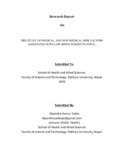Please use this identifier to cite or link to this item:
https://hdl.handle.net/20.500.14356/627Full metadata record
| DC Field | Value | Language |
|---|---|---|
| dc.contributor.author | Yadav, Dipendra Kumar | |
| dc.date.accessioned | 2012-12-28T04:42:53Z | |
| dc.date.accessioned | 2022-11-08T10:17:18Z | - |
| dc.date.available | 2012-12-28T04:42:53Z | |
| dc.date.available | 2022-11-08T10:17:18Z | - |
| dc.date.issued | 2010 | |
| dc.identifier.uri | http://103.69.126.140:8080/handle/20.500.14356/627 | - |
| dc.description | Low birth-weight is a weight at birth less than 2,500 gram (up to and including 2,499 gram) irrespective of gestational age1. More than 20 million infants worldwide, representing 15.5 percent of all births are born with low birth-weight (LBW), 95.6 percent of them in developing countries. Half of all low birth-weight babies are born in South-central Asia, where more than a quarter (27 per cent) of all infants weighs less than 2,500 gram at birth2. In Nepal, 21 and 14 percentage of low birth-weight babies was reported in DHS 2001 and 2006 respectively3. This is based on epidemiological observations that infants weighing less than 2,500 gram are approximately 20 times more likely to die than heavier (normal babies).A child's birth weight is an important indicator of a child's vulnerability to the risk of childhood illness and the chances of survival. | en_US |
| dc.language.iso | en_US | en_US |
| dc.subject | Low Birth-weight | en_US |
| dc.subject | Risk Factors | en_US |
| dc.title | The Study of Medical and Non-medical Risk Factors Associated with Low Birth-weight in Nepal | en_US |
| dc.type | Technical Report | en_US |
| Appears in Collections: | Post Graduate Grant (PG) Reports | |
Items in DSpace are protected by copyright, with all rights reserved, unless otherwise indicated.

